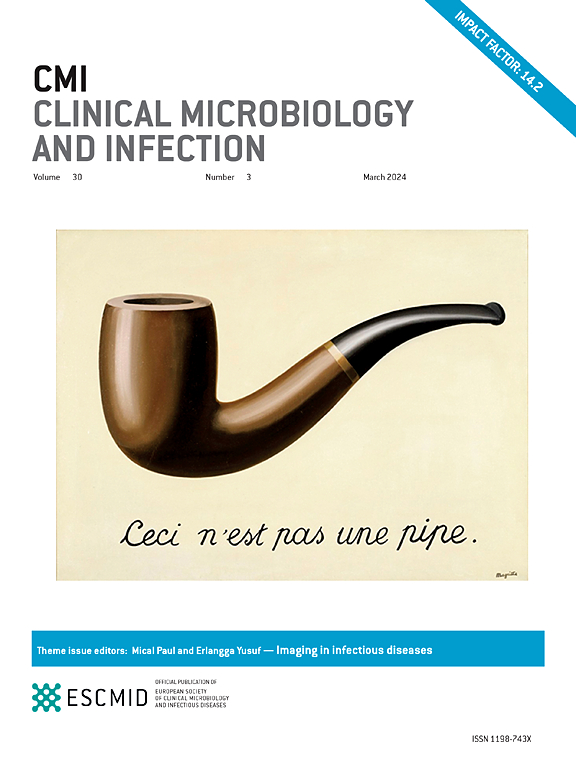Acute cough in outpatients: what causes it, how long does it last, and how severe is it for different viruses and bacteria?
IF 10.9
1区 医学
Q1 INFECTIOUS DISEASES
引用次数: 0
Abstract
Objectives
To describe the symptoms, duration, severity, and microbiology of lower respiratory tract infection (LRTI) in outpatients.
Methods
Prospective cohort study of adults in US primary or urgent care with a chief complaint of cough and symptoms consistent with LRTI. Baseline data included demographics, signs, symptoms, and PCR for 46 viruses and bacteria. The severity of symptoms reported for ≤28 days follow-up via diary and text message. The Bronchitis severity score assessed severity at baseline; overall severity was defined as the area under the symptom severity curve.
Results
Of 718 patients with complete baseline data, 618 had valid PCR results, and 443 were followed until symptoms resolved. Of those with valid PCR, 100 (16.2%) had 1+ viruses detected, 211 (34.1%) had 1+ bacteria, and 168 (27.2%) had both. Symptoms more likely with viral or mixed infection included feverishness (36.7–38.4% vs. 18.5%), chills or sweats (36.0–38.1% vs. 17.9%), being generally unwell (78.2–81.3% vs. 64.9%), and myalgias (42.7–48.2% vs. 28.6%). Coloured sputum (42.9% vs. 23.2–29.5%) was more common with a bacterial infection. The mean duration of cough was 14.7 days with viruses (95% CI: 13.2–16.2), 17.3 with bacteria (95% CI: 15.9–18.6), 16.9 with mixed infection (95% CI: 15.2–18.6), and 18.4 with no detection (95% CI: 16.1–20.8). Overall severity of cough was lower for viral infections (20.9 points, 95% CI: 18.6–23.3) than for other groups (range 24.2–26.3). The most common potential bacterial pathogens were Haemophilus influenza (28.0%), Moraxella catarrhalis (16.2%), and Streptococcus pneumoniae (10.2%), whereas the most common viral pathogens were rhinovirus (17.3%), influenza (12.8%), SARS-CoV-2 (11.5%), and seasonal coronaviruses (8.1%).
Discussion
The mean duration of cough was 16.4 days. Consistent with European studies, the type of infection or potential pathogen was not an important predictor of the duration or severity of LRTI.
门诊患者的急性咳嗽:是什么导致了咳嗽,咳嗽持续多长时间,不同病毒和细菌的咳嗽有多严重?
目的描述门诊患者下呼吸道感染(LRTI)的症状、持续时间、严重程度和微生物学:方法:前瞻性队列研究,对象为在美国初级或紧急医疗机构就诊、主诉为咳嗽且症状符合 LRTI 的成人。基线数据包括人口统计学、体征、症状以及 46 种病毒和细菌的 PCR 检测。通过日记和短信报告长达 28 天的随访症状严重程度。支气管炎严重程度评分(BSS)评估基线时的严重程度;总体严重程度定义为症状严重程度曲线下的面积:在基线数据完整的 718 名患者中,618 人的 PCR 结果有效,443 人接受了随访,直至症状缓解。在 PCR 结果有效的患者中,100 人(16.2%)检测到 1+ 病毒,211 人(34.1%)检测到 1+ 细菌,168 人(27.2%)同时检测到病毒和细菌。病毒感染或混合感染更可能出现的症状包括发热(36.7% 至 38.4% vs 18.5%)、发冷或出汗(36.0% 至 38.1% vs 17.9%)、全身不适(78.2% 至 81.3% vs 64.9%)和肌痛(42.7% 至 48.2% vs 28.6%)。细菌感染时,痰液带色(42.9% 对 23.2% 至 29.5%)的情况更为常见。病毒感染者咳嗽的平均持续时间为 14.7 天(95% CI 13.2-16.2),细菌感染者为 17.3 天(95% CI 15.9-18.6),混合感染者为 16.9 天(95% CI 15.2-18.6),未检测到病毒者为 18.4 天(95% CI 16.1-20.8)。病毒感染者的总体咳嗽严重程度(20.9 分,95% CI 18.6-23.3)低于其他组别(范围 24.2-26.3)。最常见的潜在细菌病原体是流感嗜血杆菌(28.0%)、白喉摩拉菌(16.2%)和肺炎链球菌(10.2%),而最常见的病毒病原体是鼻病毒(17.3%)、流感(12.8%)、SARS-CoV-2(11.5%)和季节性冠状病毒(8.1%):结论:咳嗽的平均持续时间为 16.4 天。结论:咳嗽的平均持续时间为 16.4 天。与欧洲的研究结果一致,感染类型或潜在病原体并不是预测 LRTI 持续时间或严重程度的重要因素。
本文章由计算机程序翻译,如有差异,请以英文原文为准。
求助全文
约1分钟内获得全文
求助全文
来源期刊
CiteScore
25.30
自引率
2.10%
发文量
441
审稿时长
2-4 weeks
期刊介绍:
Clinical Microbiology and Infection (CMI) is a monthly journal published by the European Society of Clinical Microbiology and Infectious Diseases. It focuses on peer-reviewed papers covering basic and applied research in microbiology, infectious diseases, virology, parasitology, immunology, and epidemiology as they relate to therapy and diagnostics.

 求助内容:
求助内容: 应助结果提醒方式:
应助结果提醒方式:


